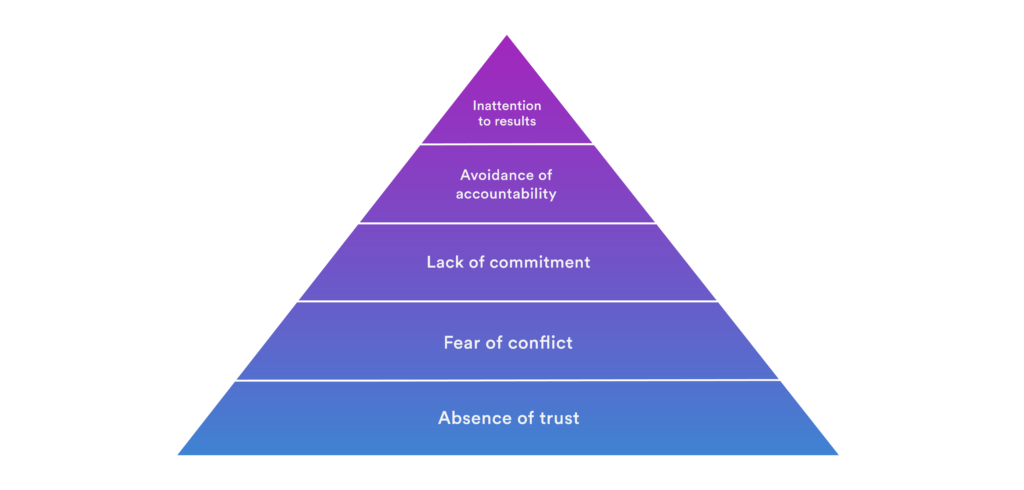How to improve teamwork effectiveness in 5 simple steps

“Not finance. Not strategy. Not technology. It is teamwork that remains the ultimate competitive advantage, both because it is so powerful and so rare.”
Patrick Lencioni
The dream for any business is to have every team within it sharing the same company vision, rowing in the right direction, each one working to their full potential to achieve collective success.
But in the majority of cases, teams fragment, individuals leave and managers are left frustrated by the lack of alliance among their departments. And in a number of instances, senior level are mistakenly under the impression that their teams are working just as well as they are. But for the best part, they are doing anything but.
So, how do you know if your team is working effectively together? The lack of conflict? The assumption that everyone is doing their job correctly? The fact that no-one questions the status quo?
Employee collaboration in the digital workplace
According to research done in the field of business management, when there is no challenging of behaviors, no curiosity in alternative methods, no accountability: there is no teamwork. Patrick Lencioni, in his studies of CEOs and Fortune 500 companies, has found the five questions that you should be asking to assess what state of health your team is in:
- Do your team members openly and readily disclose their opinions?
- Are your team meetings compelling and productive?
- Does your team come to decisions quickly and avoid getting bogged down by consensus?
- Do your team members confront one another about their shortcomings?
- Do your team members sacrifice their own interests for the good of the team?
If you’re answering ‘no’ to one or more of these questions, you’re not alone. Most businesses need to apply at least some work into building their teams up. But for many, it seems too complex a situation to sort, and can often be a very messy job. Yes, you may find in creating a team that works effectively, that a little bit of deconstruction is necessary. But the reward is that you get the individuals who are willing to put in the effort, humility, and determination to collectively reach your goals.
When there is no challenging of behaviors, no curiosity in alternative methods, no accountability: then there is no teamwork.
Teams in most businesses do not function to their full potential without some significant organizing. In order to succeed, hard work is required to get your team to work together effectively.
The problems with teams

How do teams become so dysfunctional so quickly? Surely, all that is needed is to gather up bright-eyed and talented people to create team success?
Sadly, it’s not that simple. Teams are made up of individuals who bring strengths and weaknesses to the group. Even the hardest working, most well-intentioned employees can bring negative behaviors to an organization. There are egos, opinions, and emotions to navigate around if you want a team that works in harmony. But it’s not impossible to stop these traits impacting the health and productivity of your team.
You just need to know what to look out for, what needs to be done to quell negative behaviors and how you can promote new ways of working together.
The 5 dysfunctional pitfalls of teamwork

In Lencioni’s work, he came across the five main dysfunctional pitfalls of teamwork. These are the five most common symptoms of a team that no longer works effectively. They are as follows:

Absence of trust: How do you identify an absence of trust? If you’re wondering if your team is missing this vital team-gluing element, then you need to look and see how frank discussions are in meetings. If there is frankness, and people are asking their colleagues professionally penetrating questions, then you have a vulnerability-based trust that exists within the team. This is a good thing and means that each individual feels secure enough to ask questions that, in most other teams, could expose them to ridicule, resentment or conflict. However, so many teams feel unable to question their colleagues, that resentment grows and productivity dips as a result. When you have trust, you have a team that has the confidence to expose any potential derailment and manage it accordingly.
While many of us go to great lengths to avoid conflict, the thing that we are avoiding could actually be essential to long term business success
Fear of conflict: While many of us go to great lengths to avoid conflict, the thing that we are avoiding could actually be essential to long term business success. Unresolved conflict never goes away, it just stews and simmers until a member of staff leaves, or it blows up into a full-scale crisis. Conflict is difficult, and it can often feel easier to let it pass, but what is actually easier is to face it head-on. That is the only way you can reach solutions, come up with ideas and become more adept at a team at solving problems. You can have a harmonious team and still not be afraid of confrontation. As Ronald Reagan said, “Peace is not an absence of conflict. It is the ability to handle conflict by peaceful means.” You just need to make sure the conflict is constructive, and both sides are willing to listen and seek resolution.
Employee collaboration in the digital workplace
Lack of commitment: This is connected to the absence of trust, where individuals are afraid to speak up and present their opinion. When employees feel that they have to keep an unpopular opinion to themselves, they soon become disengaged. Consenting to something just to keep the peace is incredibly negative to business- after all, why oppose something if no one will take on your concerns constructively? On the surface of things, it appears that your team is in agreement, however, no team is ever in total consensus without debate, discourse and some amount of compromise. So, when you’re getting everyone’s opinion, and they’re all in accordance first time around – that’s usually a sign that they have long stopped caring about putting their thoughts and voices forwards. And as a manager, if you take this consensus on face value, you may not be analyzing things carefully enough.
Avoidance of accountability: Accountability can be tricky. Many employees hide their lack of accountability through bluster, working on irrelevant projects or simply by being really helpful on other matters that aren’t their own. And when friendships with colleagues develop, it can become difficult to broach the subject of their jobs. This is when managers need to be aware of each individual’s performance and the way it relates to the rest of the team. Managers also need to promote clarity and the importance of every team member having equal buy-in. A push from a colleague should not be interpreted as interfering and intrusive, but as a supportive nudge to reach the collective goal.
When your team are ambiguous about your goal, they’re ambivalent about the results.
Inattention to results: How does your team define success? Is it focusing on the long-term goal and measuring your results? Or is it something else? When teams aren’t working effectively, it’s usually because the focus of work is on something else. Teams need to define their targets and goals and work from there. Focus on this, and you avoid ego politics, inefficiency and losing your competitive edge. When your team are ambiguous about your goal, they’re ambivalent about the results. Make sure everyone is clear about what needs to be achieved to succeed, and you have a team that is cohesive, accountable and focused.
The 5 simple steps for cracking teamwork effectiveness

Now we’ve identified the five main stumbling blocks for teamwork, we can turn our attention to the five things you can do to build your team up.
- Define your goals clearly – no journey takes place without a defined destination. When you are traveling to Point B, you work out the quickest way of getting there, what weather conditions could hamper the journey, check that your vehicle is in the right condition to travel, and fit in any relevant rest stops. The same happens with your team: you need to involve them in exactly what it is that you want them to aim for. Get them focused on the goal, check you’ve got the right amount of resources on board and work out how to avoid any hindrances or handicaps.
- Be transparent – Promote transparency and you and your team are able to have clarity over the project: who does what, when and how. This overcomes the accountability issue detailed above, and you also have clear access to all the information and data you need. In teams with a lack of transparency, information is withheld and ownership is obscured – clear stumbling blocks to achieving success. Practise transparency and the workload is more balanced, there are more ways to problem-solve and a clear unified direction emerges.
Promote transparency and you and your team are able to have clarity over the project: who does what, when and how.
- Employee recognition – Another massive contribution to effective teamwork is recognizing performance. Employment recognition is so impactful to a positive culture, but so often overlooked. There are many ways to celebrate a great performance, so it’s recommended that the protocol is in place for those occasions when it’s time to say ‘well done.’ Making sure your people are recognized for great work is a huge motivating force, and greatly satisfying for team members. It’s also important for colleagues to congratulate others on their success.
- Keep focus on your progress – When you’re working on a project, you need to have some kind of visual to inform your team how far along they are. Making sure everyone has a daily reminder of their accomplishments and how far they have to go is instrumental to the drive of the team. These visuals can track any slowing down, and performance issues, and can also highlight what areas are working well. Visuals provide one source of truth, so there’s nothing there that is open to interpretation. They are clear and effective way to track performances.
- Leave your egos at the door – When it comes to effective team working, it’s important to remember that there is no room for egos. Take on board constructive criticism and listen. By displaying an open mind, you’re able to act as an example to others. People should feel free to voice opinions, even if it might jar against your own – teamwork relies on openness and transparency. Once you have this, your team can solve problems, work out new ideas and have a renewed confidence in working together. Disputes will lead to cohesion.

But like all things worth doing, this requires effort, discipline, and persistence. While it’s up to the manager to maintain the status quo, it also falls on to the employees to make sure they keep themselves and others in check. However, once new staff members join the team and witness this effective teamwork behavior, it will eventually become self-perpetuating.

